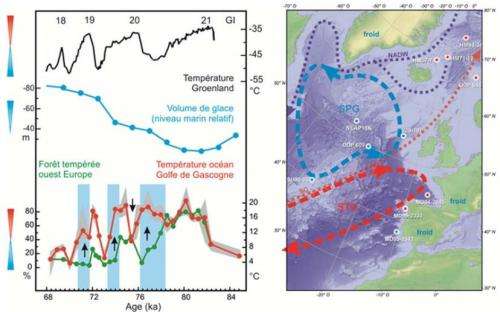The paradox of polar ice sheet formation solved

The beginning of the last glacial period was characterized in the Northern hemisphere by major accumulation of snow at high latitudes and the formation of a huge polar ice sheet. For climatologists this was paradoxical, since snowfall is always associated with high humidity and relatively moderate temperatures. Now, a French team coordinated by MaríaFernanda Sánchez-Goñi, a researcher at EPHE working in the 'Oceanic and Continental Environments and Paleoenvironments' Laboratory (CNRS/Universités Bordeaux 1 & 4) has solved this paradox. By analyzing sediment cores dating from 80 000 to 70 000 years ago, the researchers have shown that during this period water temperatures in the Bay of Biscay remained relatively high, whereas temperatures in mainland Europe gradually fell. Carried northwards by wind, the humidity released by this thermal contrast appears to have caused the snowfall that formed the polar ice sheet. Their work was published on the Nature Geoscience website on September 1, 2013.
Over the past two million years, the Earth has experienced long glacial periods separated by short, warmer periods known as interglacials. This succession of glacials and interglacials is caused by changes in insolation brought about by cyclical variations in the distance between the Earth and the Sun and in the tilt and direction of our planet's axis relative to the Sun. The last glacial period, which ended 12 000 years ago, began between 80 000 and 70 000 years ago. This period was marked by climate variability at
millennial time scales, with short cooling periods alternating with less and less marked improvements in the climate as glaciation set in.
70 000 years ago, following a reduction in insolation, sea levels fell by 80 meters. This shows that there was a large accumulation of snow at high latitudes, which was the cause of the ice sheet around the North pole. However, cold temperatures are generally associated with dry weather and scarce precipitation. For snow to fall, the weather needs to be humid and the temperature only moderately low. In these conditions, how can the accumulation of snow at the pole be explained?
To answer this question, the researchers analyzed marine sediment cores collected off Galicia (Spain) and from the Bay of Biscay, containing pollen and foraminifera, microscopic marine organisms with calcareous skeletons. Pollen grains are excellent indicators of the vegetation and temperature of the continent, while foraminifera provide information about the temperature of the ocean.
The scientists were thus able to reconstruct changes in the vegetation cover of the Atlantic seaboard and in the temperatures of the Atlantic Ocean. They observed an astonishing decoupling between the temperature of the Bay of Biscay and that of the European mainland. When temperatures were very cold on the mainland, the oceans remained warm, especially during the periods of intense cooling that took place at the onset of glaciation. The decoupling corresponds to periods when the Gulf Stream, a powerful marine current that transports the warm waters of the Gulf of Mexico northwards, was pushed towards the Bay of Biscay by the moderate breakup of icebergs from the North of the American continent. It is the temperature contrast between the Bay of Biscay and the adjacent mainland that released high humidity, which was carried towards the North pole by the winds, thus causing, according to the researchers, the heavy snowfall that formed the polar ice sheet.
More information: Air-sea temperature decoupling in Western Europe during the last interglacial/glacial transition María-Fernanda Sánchez-Goñi, Edouard Bard, Amaelle Landais, Linda Rossignol, Francesco d'Errico. Nature Geoscience, 1 September 2013. DOI: 10.1038/ngeo1924
Journal information: Nature Geoscience
Provided by CNRS


















